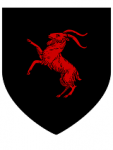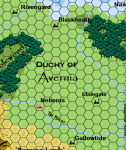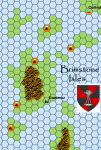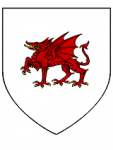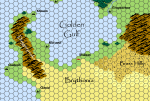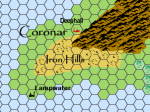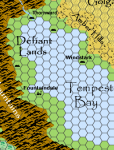Rhineglade
Adventurer
AELINORE
Official Name: Fell-Empire of Aelinore
Ruler: His Grim and Terrible Authority, Mathraxis the Everliving, Autocrat of Aelinore, Overlord of Hyperion, Scourge of the Lower Planes, Commander of the Undead Hordes (NE Human undead male, Wiz 20/Clr 10)
Coat of Arms: Shield divided party per pale Gules and Sable, a griffin segeant Argent, crest of winged skull Argent with wings Gules and crowned Or, with mantle Gules and Sable
Government: Independent autocratic empire ruled by an undead monarch; Mathraxis has complete authority in all manner of government and rules through fear, manipulation and intimidation; his most devout followers are given high positions within the government and rule in their master's name
Notable Figures: Nainenwithel (CE Medium undead vample (shapechanger) female, Ftr 12); Commander Skirdur (LE Human male, Brb 17); Charcerwyd, Chief of the Secret Police (CE Medium humanoid (human, shapechanger), Rog 15); High Priest Kerebos (NE Human male, Clr 18)
Rule of Law: Neutral Evil. Moderate law codes exist within the country but they are either enforced or not enforced based on the situation. Selfish needs of the individual or state are of paramount importance. The evil nature of the state may not actively engage in abject carnage but will have no compunction for harming others if necessary. Doing evil or evil's sake is the goal. Laws are only good as long as they do not get in the way of the ultimate goals of the state.
Population: 275,000
Capital: Geyathrad (pop. 53,000)
Major Cities: Barrowfield, Naxos, Spineheart
Major Religions: Mathraxis, Kharon, Tormac, Demoriel, Abraxas, Molghur
Major Resources: Few
Military: 20,000+ (composed of humanoid and undead heavy and light infantry augmented by human and undead heavy and light cavalry)
Allies: Golgathor, Draugmore, Rhuthune, Avernia
Enemies: Rendore, Tritheria, Meridia, Hrathgar, Defiant Lands (sometimes)
The dread realm of Aelinore is a nation bound by the Stagflow river on the West, the Brightwater to the North, the Ardos river on the East and the Hollowing Bay to the South. One of the more desolate realms on Hyperion, badlands, barrens and strong winds from the North are the predominant features of this region.
The central region of Aelinore is a wide plateau carved out over the eons by the rush of the Stagflow and Ardos rivers as they flow southward into the Hollowing Bay. The northern frontierlands are covered with heath, course grasses and ferns which give way to the true woodlands of the Scragwood Forest along the southern shores of the Brightwater. Much of this central plateau is composed of limestone. While moderate rainfall occurs throughout the year, most of it is absorbed by the karst (underground drainage and sinkholes) in the region. Formations of minor fissures, cracks, sinkholes and canyons are not uncommon making travel within Aelinore somewhat treacherous. Rainfall empties into these depressions forming significant underground rivers that eventually empty into the Hollowing Bay or Brightwater Sea. Vast caverns and subterranean tunnels form an underground network connected to channels formed by years of erosion. Foul humanoids are known to dominate this ecosystem with orcs and goblins in abundance.
As the region is known for its limestone, fertile farmland is in short supply. Once part of the northernmost portion of the dragonborn Brythonia Empire, the region was dominated by Voltari, Comori and Altari human tribes as the dragonborn empire collapsed and withdrew. Around the 14th-century of the 4th Age, a dark force began to slowly form in the slums of Geyathrad, the only city in the area of any significance at the time. The wizard Mathraxis is said to be the unholy spawn of a wretched Comorian sorceress and a devil of the Everhells. Some stories even mention that his father was no less than an avatar of the Dread Lord Kharon, god of death himself! In either case, it is apparent that the formidable wizard has some supernatural heritage. His rise to power and ability to maintain control within the region was both stunning and remarkable, even for the most prominent mages. With his command of powerful magic, Mathraxis gathered a small but loyal following of henchmen and servants. Using ancient spellcraft, followers and mercenaries, the wizard conquered large portions of Aelinore gathering more under his banner. Within a few scant years, he succeeded in dominating his home city of Geyathrad and most of the plains between the Stagflow and Ardos rivers.
Official Name: Fell-Empire of Aelinore
Ruler: His Grim and Terrible Authority, Mathraxis the Everliving, Autocrat of Aelinore, Overlord of Hyperion, Scourge of the Lower Planes, Commander of the Undead Hordes (NE Human undead male, Wiz 20/Clr 10)
Coat of Arms: Shield divided party per pale Gules and Sable, a griffin segeant Argent, crest of winged skull Argent with wings Gules and crowned Or, with mantle Gules and Sable
Government: Independent autocratic empire ruled by an undead monarch; Mathraxis has complete authority in all manner of government and rules through fear, manipulation and intimidation; his most devout followers are given high positions within the government and rule in their master's name
Notable Figures: Nainenwithel (CE Medium undead vample (shapechanger) female, Ftr 12); Commander Skirdur (LE Human male, Brb 17); Charcerwyd, Chief of the Secret Police (CE Medium humanoid (human, shapechanger), Rog 15); High Priest Kerebos (NE Human male, Clr 18)
Rule of Law: Neutral Evil. Moderate law codes exist within the country but they are either enforced or not enforced based on the situation. Selfish needs of the individual or state are of paramount importance. The evil nature of the state may not actively engage in abject carnage but will have no compunction for harming others if necessary. Doing evil or evil's sake is the goal. Laws are only good as long as they do not get in the way of the ultimate goals of the state.
Population: 275,000
Capital: Geyathrad (pop. 53,000)
Major Cities: Barrowfield, Naxos, Spineheart
Major Religions: Mathraxis, Kharon, Tormac, Demoriel, Abraxas, Molghur
Major Resources: Few
Military: 20,000+ (composed of humanoid and undead heavy and light infantry augmented by human and undead heavy and light cavalry)
Allies: Golgathor, Draugmore, Rhuthune, Avernia
Enemies: Rendore, Tritheria, Meridia, Hrathgar, Defiant Lands (sometimes)
The dread realm of Aelinore is a nation bound by the Stagflow river on the West, the Brightwater to the North, the Ardos river on the East and the Hollowing Bay to the South. One of the more desolate realms on Hyperion, badlands, barrens and strong winds from the North are the predominant features of this region.
The central region of Aelinore is a wide plateau carved out over the eons by the rush of the Stagflow and Ardos rivers as they flow southward into the Hollowing Bay. The northern frontierlands are covered with heath, course grasses and ferns which give way to the true woodlands of the Scragwood Forest along the southern shores of the Brightwater. Much of this central plateau is composed of limestone. While moderate rainfall occurs throughout the year, most of it is absorbed by the karst (underground drainage and sinkholes) in the region. Formations of minor fissures, cracks, sinkholes and canyons are not uncommon making travel within Aelinore somewhat treacherous. Rainfall empties into these depressions forming significant underground rivers that eventually empty into the Hollowing Bay or Brightwater Sea. Vast caverns and subterranean tunnels form an underground network connected to channels formed by years of erosion. Foul humanoids are known to dominate this ecosystem with orcs and goblins in abundance.
As the region is known for its limestone, fertile farmland is in short supply. Once part of the northernmost portion of the dragonborn Brythonia Empire, the region was dominated by Voltari, Comori and Altari human tribes as the dragonborn empire collapsed and withdrew. Around the 14th-century of the 4th Age, a dark force began to slowly form in the slums of Geyathrad, the only city in the area of any significance at the time. The wizard Mathraxis is said to be the unholy spawn of a wretched Comorian sorceress and a devil of the Everhells. Some stories even mention that his father was no less than an avatar of the Dread Lord Kharon, god of death himself! In either case, it is apparent that the formidable wizard has some supernatural heritage. His rise to power and ability to maintain control within the region was both stunning and remarkable, even for the most prominent mages. With his command of powerful magic, Mathraxis gathered a small but loyal following of henchmen and servants. Using ancient spellcraft, followers and mercenaries, the wizard conquered large portions of Aelinore gathering more under his banner. Within a few scant years, he succeeded in dominating his home city of Geyathrad and most of the plains between the Stagflow and Ardos rivers.


